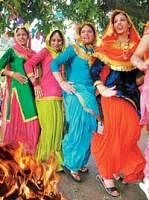

Lohri marks the end of winter on the last day of Paush, and beginning of Magha (around January 13 and 14). Lohri, fundamentally an agricultural festival is connected with merry-making. There’s belief that worshipping the sun, the energy giver, leads to harmony, prosperity and peace.
Lohri is essentially a festival dedicated to fire and the sun god. Fire is associated with concepts of life and health. Fire, like water, is a symbol of transformation and regeneration.
It is the representative of the sun, and is thus related, on the one hand with rays of light, and on the other with gold. It is capable of stimulating the growth of cornfields and the wellbeing of man and animals.
It is the imitative magic purporting to assure the supply of light and heat. It is also an image of energy and spiritual strength. Heat and fire — the driving forces of our lives signify the move of sun towards the Uttarayan astrologically for securing warmth towards the heaven.
It is the time when the sun transits the zodiac sign Makar (Capricorn), and moves towards the north. The new configuration lessens the ferocity of winter, and brings warmth to earth. It is to ward off the bitter chill of the month of January that people light bonfires, dance around it in a mood of bonhomie and celebrate Lohri.
That is why the Lohri fire gets sanctified and is venerated like a deity. On this occasion, people offer peanuts, popcorn and sweets made of til — chirva, gajak and revri — to propitiate fire as a symbol of the sun god.
Lohri is almost adjacent to Makar Sankranti that also symbolises a celebration of plenty. The festival has its own strong regional flavours and has been celebrated with a lot of fervour with Punjab taking the lead and Delhi, Gujarat, Karnataka, Tamil Nadu, Bengal and Assam following closely. Interestingly, though not strangely, the same festival in Tamil Nadu is known as Pongal, in Gujarat and Bengal as Makar Sankranti, and in Assam as Magha Bihu.
The Punjab and other areas of North India get very cold in the month of January, and usually the period of the last week of December and the first couple of weeks in January are the coldest of the season. However, after Lohri, the temperature gradually starts rising.
However, not trivialising the religious, ritualistic and social importance of the festival, I would say that this warmth is a time of regeneration as part of the holy trinity of Brahma, Vishnu and Shiva. With the movement of the sun towards the west, the new holistic murmur rejuvenates us all.
There are some interesting socio-cultural and folk-legends connected with Lohri. According to the cultural history of Punjab, Bhatti, a Rajput tribe during the reign of Akbar, inhabited parts of Rajasthan, Punjab and Gujarat (now in Pakistan). Dulla Bhatti, Raja of Pindi Bhattian, was put to death by the Mughal king for revolting against him. The tribal mirasis (street singers) trace the history of the tribe and interestingly claim Maharaja Ranjit Singh as one of its scions.
This is particularly a happy occasion for couples who for the first time celebrated Lohri after their marriage and also the first Lohri of the son born in a family. Children visit homes in the neighbourhood and sing songs. One of the famous ones is: “Dabba bharaya leera da/ Ai ghar ameera da” (box is filled with cloths strips/ This house is of the rich).
Ceremonies that go with the festival of Lohri usually comprises of making a small image of the Lohri goddess with gobar (cattle dung), decorating it, kindling a fire beneath it and chanting its praises. The final ceremony is to light a large bonfire at sunset, toss sesame seeds, gur (jaggery), sugar-candy and revries in it, sit round it, sing, dance till the fire dies out. People take dying embers of the fire to their homes.
In Punjabi village homes, fire is kept going round the clock by use of cow-dung cakes.
The men folk of the villages perform bhangra (an energetic Punjabi dance) on this day that is also associated with the ripening of crops. The dance manifests the vigour and vitality and exuberance of the people, in anticipation of money coming in after the cutting of a good harvest. During Lohri celebration, the drum plays a very important part. It provides the basic accompaniment to most of folk music.